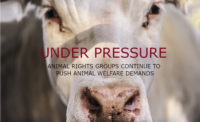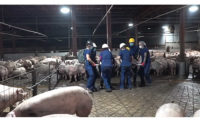Animal welfare has remained a key issue for the Animal Agriculture Alliance since its founding in 1987 because of frequent efforts by animal-rights organizations to spread myths and misinformation about this important topic. Those involved in the animal agriculture community know firsthand that animal care is the No. 1 priority of farm families. By contrast, the No. 1 priority of animal-rights activist organizations is to eliminate animal protein from our diets. These organizations often work to harm the reputation of America’s farm families by misleading and misinforming consumers. Their goal is to make eating meat unaffordable as well as socially unacceptable while raising funds to further their cause.
It’s important to note the very real difference between “animal welfare” and “animal rights.” The American Veterinary Medical Association says animal welfare refers to “how an animal is coping with the conditions in which it lives.” An animal is considered to be in a good state of welfare if – as indicated by scientific evidence – “it is healthy, comfortable, well-nourished, safe, able to express innate behavior, and if it is not suffering from unpleasant states such as pain, fear, and distress. On the other hand, animal rights is the concept of treating animals as equal to humans. Tracy Reiman with People for the Ethical Treatment of Animals (PETA) put it very plainly, stating, “We are opposed to any exploitation of animals. Not just bigger cages, no cages. Not just less domination but no dominating. Not just making sure they are anesthetized before being killed for a shoe or a steak but not being killed for either.”
Animal welfare issues presented to the media, legislators, and food brands are often touted as being supported by the general public, but the reality is the “issues” are almost solely pushed by animal-rights organizations hoping to persuade consumers to feel the same as they do. Because of the extremism of most animal rights views and concerns, most consumers do not share the same views. Nonetheless, we must stay vigilant to the issues activists push to safeguard the future of the animal agriculture community and remind consumers we share the same interest in animal welfare.
Animal housing systems have been a huge target for animal rights groups over the past year. Delcianna Winders with the Center for Animal Law Studies at Lewis and Clark Law School, a partner of the Animal Legal Defense Fund, recently said, “In the United States, animals are intensively raised in tight confinement, barely able to move, let alone engage in their most basic behaviors like nesting, digging, grazing and so on.” The use of cages for egg-laying hens and gestation stalls for farrowing pigs have specifically been battled by activist groups, even though science and research consistently point to their benefits (and even preference from the animals). Several states have introduced – and in some cases passed – legislation requiring the elimination of these production methods.
Food brands are also being targeted, as activist groups such as Compassion in World Farming push for them to adopt the Better Chicken Commitment (BCC) for broiler-chicken supply chains. The primary requirement of the BCC is adherence to animal welfare standards put in place by Global Animal Partnership (GAP), a highly activist-influenced organization. GAP standards are also subject to change, so they may evolve in the future beyond what companies thought they were committed to. Several animal-rights organizations are working collaboratively to pressure food brand contacts into committing to these standards.
Looking to the future, an increasing focus of activist organizations is aquaculture or farm-raised fish. The release of the Netflix documentary “Seaspiracy” brought seafood and the way it’s raised into the spotlight over the past year, and activists have run with it. Mary Finelli of Fish Feel stated at a recent activist conference, “Tragically, fishes comprise by far the largest category of functionally exploited vertebrate animals. They’re subjected to some of the worst abuse and they receive the least public concern or legal protection.” The Alliance anticipates continued targeting of aquaculture and the seafood community in general by activist organizations. This may include an increase in attempts to obtain undercover video footage from aquaculture facilities that can be twisted to fit their narratives and strengthen future campaigns. All farms and facilities are encouraged to brush up on security protocols to protect themselves from possible activist attacks.
While the animal agriculture community continues to find ways to improve the lives of the animals it cares for, animal-rights activists will not stop until their end goal of taking animal products off our tables is reached. It’s imperative that we keep animal welfare top of mind and practice science-based husbandry practices so we can confidently share with consumers that we’re raising our animals in the best way possible while working to dispel misinformation shared by activist groups.



Report Abusive Comment